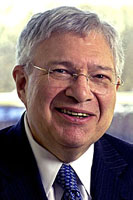At the first annual Robert H. Kirschner Memorial Human Rights Lecture—named in memory of Robert Kirschner, who helped found the U of C's Human Rights Program —speaker Sara Paretsky, AM'69, MBA'77, PhD'77, recalled her first meeting with Kirschner, a forensic pathologist and international human-rights activist: on a private tour of the Cook County morgue. Kirschner worked for the Medical Examiner's Office, and Paretsky—the author of a mystery series on private inspector V. I. Warshawski—was doing research.
"I've never fainted," Paretsky told the crowd of 150 in Social Sciences 122, but when Kirschner "sawed off the back of a suicide victim's head and scooped out the brains, I almost did." The procedure was standard in a nonaccidental-death autopsy.
Set in Chicago, Paretsky's novels abound with scenes that require a familiarity with, for example, the Cook County morgue. Her reading Thursday was not about the "made-up world of violent crime," however, but her concerns about the real world: the rise of mega-publishers, civil liberties in the aftermath of 9/11, and the Patriot Act.
Paretsky read a version of "Truth, Lies, and Duct Tape," an essay in her forthcoming book Writing in an Age of Silence. Writing, she said, is "a movement from silence to speech"—speech that may then be censored by market forces, public hysteria, or the government. When her first book was published 25 years ago, Paretsky said, there were about 20 publishers to go to. Now there are "only seven—Disney, Time Warner," and other media conglomerates who focus on what sells.
The government also restricts freedom, she said, noting that the Patriot Act requires libraries served with FBI letters to turn over some patron records to the National Security Administration—but they libraries can't reveal they've gotten such a letter. A New Jersey patron was imprisoned for two days without being able to call his wife, Paretsky said, because he was looking at foreign-language pages on the Internet.
"What is the appropriate response as a writer in times like these?" Paretsky asked. The best she could do, she said, was to "fumble my way as close as I can to the truth." As for the audience, "We have to decide where our most effective sphere of action lies and take on those actions."
Jenny Fisher, '07
Photo: Author Sara Paretsky reads in the Social Sciences building.
























